
NIKKI Peucang Resort
The Best Beachfront Resort Within Reach of Jakarta
Guide to Animal Observation on Small Savanna at Peucang Island
Morning Edition
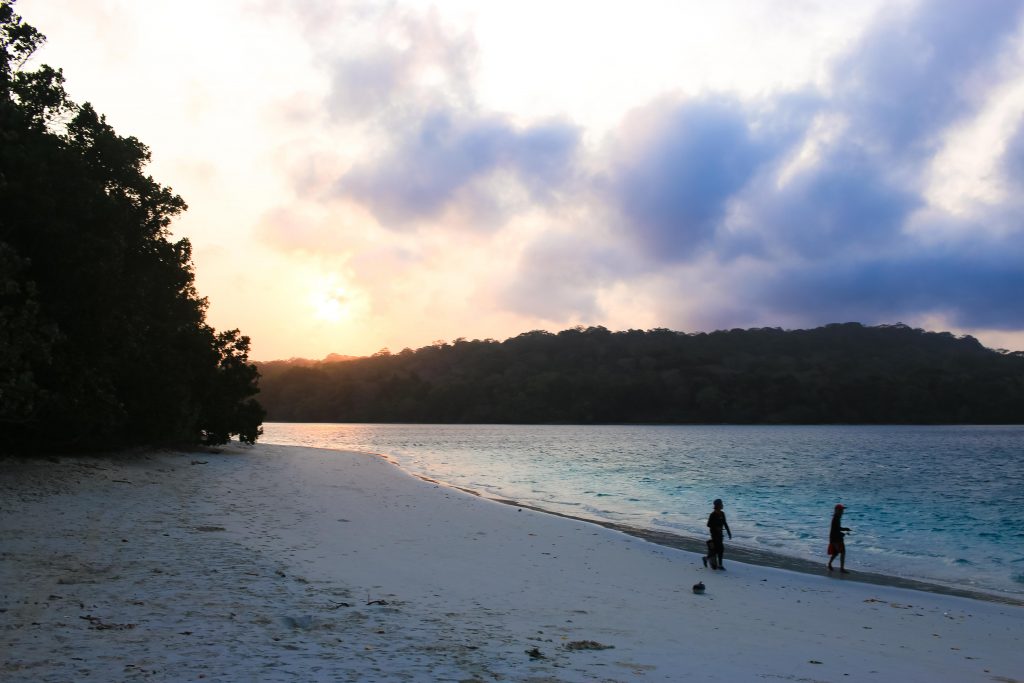
Mornings on Peucang Island are never quiet. But it’s not the noise of the engine that fills the air. Morning is the time for herds of deer to graze, a tribe of monkeys sneaking around looking for food, black storks lurking on the beach, birds flying and singing, and a small sea creature jumping away from the big jaws that want to prey on them. In the morning, this lovely and isolated island hustle and bustles with the sound of waves and the sounds and movements of crepuscular animals (active only in the morning and evening) and diurnal animals (doing activity all day and resting at night).
If you are planning to go to Peucang Island and are interested in observing animals, the small savanna on Peucang Island could be the ideal place. The size is about 1 hectare. The location is very close to the Peucang Island pier. It won’t take two minutes to be in this small savanna. NIKKI Cafe is right on the front line of the savanna that leads to the beach. So, we could say that this small savanna on Peucang Island is the backyard of NIKKI Cafe, the only restaurant on Peucang Island.
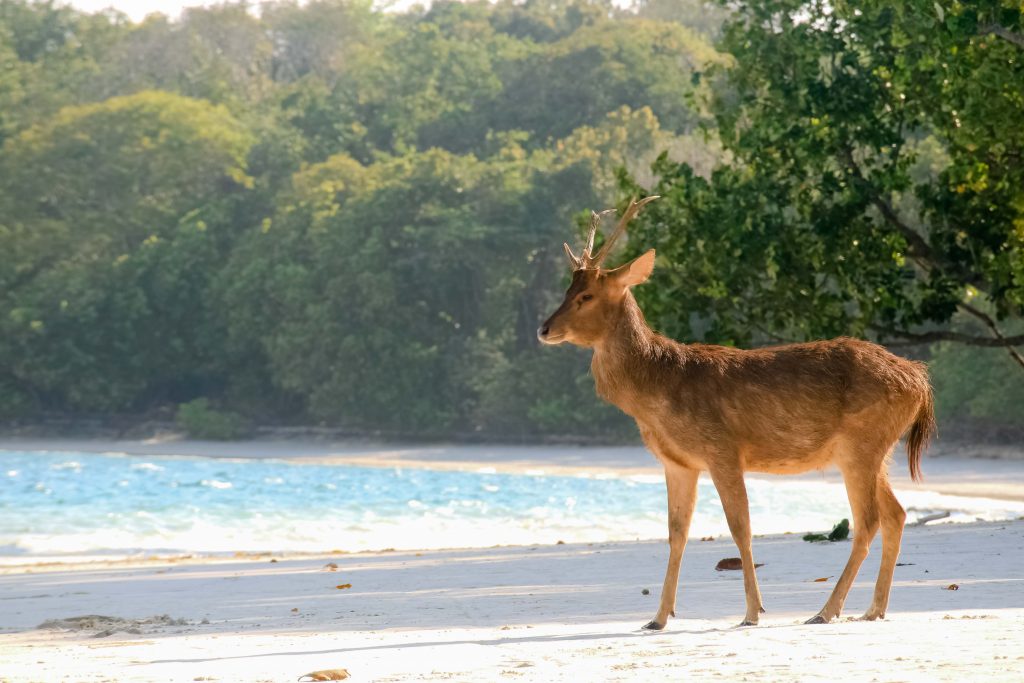
In the morning, in this savanna, we can see herds of deer, long-tailed monkeys, and wild boars. If you’re lucky, you might even see some peacocks and peafowls. Deer, wild boars, and monkeys are large mammals. Experts such as Clutton-Brock (1977) said that the activity of mammals is high during the morning and evening. And mammals in the savanna of Peucang Island are easier to find in the morning and evening. If you are interested in observing animals on the savanna in the morning, it is best to start at 5.30 am, when the light of dawn begins to reveal the fresh green color of the grass. If the sun is too bright, usually the animals disappear.
According to researchers from the Biology Department, Pakuan University, Bogor, the most active mammals on Peucang Island in the morning are the long-tailed monkey (Macaca fascicularis) and the second is the deer (Muntiacus muncak). This can be concluded from the comparison of the number of individual animals that are seen doing activities in the morning. Savana Peucang is only a small part of their research location in 2018 which has a total track length of 9 km. From their observations, these scientists met 68 monkeys, 38 deer, and 12 wild boards in the morning. In the savanna itself, in the morning, visitors can easily meet around 20 monkeys, 10 deer, and 2 wild boards.
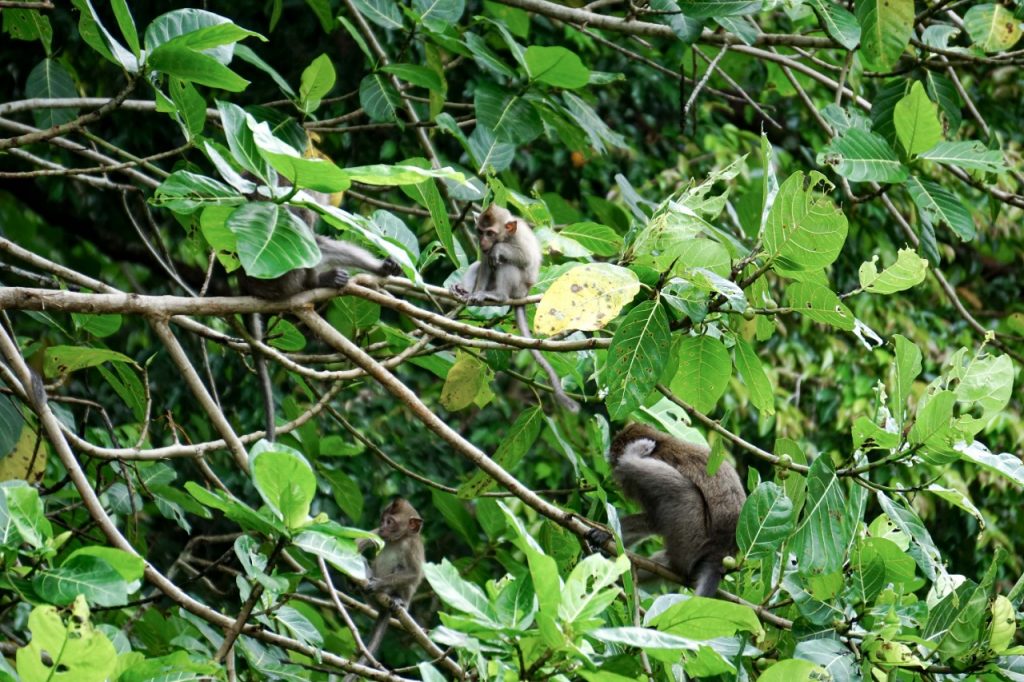
Long-tailed Monkey
According to observers from IPB, the monkey population in Peucang in 2022 is likely or suspected to be at 250 individuals. These monkeys live in groups. When they studied the monkey population on Peucang Island in 2014, they noted that there were four groups of monkeys with a total population of 82 individuals. Each group of monkeys controls an area, with members varying from 9 to 42 individuals per group.
So, there are groups of monkeys that, for example, control the savanna area, the western beach area, the middle of the forest, and other areas on Peucang Island. They do not enter each other’s territory. In 2022, the number of groups and members may grow because the total population has also increased. But it seems the group of monkeys that dominate the savanna area to the beach near the pier has a large number of members. There are currently more than 50 of them. The national park staff suggested that the group of monkeys with many members is indeed the group that controls the coastal area around the pier to the savanna.
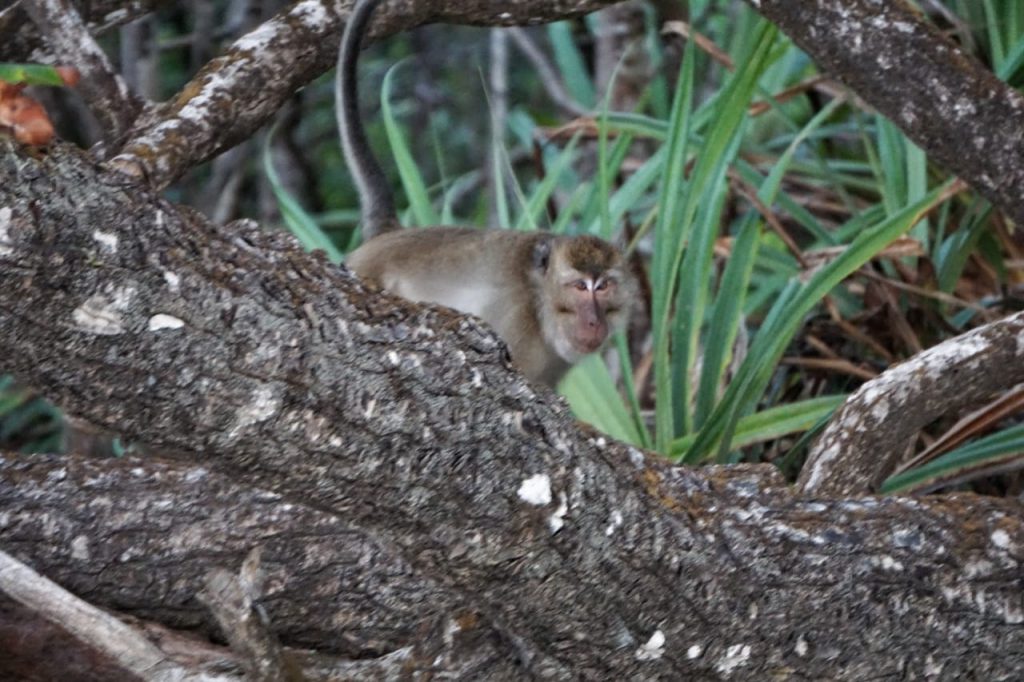
Savanna areas and beaches near the pier are favorite places for monkeys to find food. The reason is that this area is full of tourists and they can get food from visitors. It is a behavior change caused by several visitors who like to feed them. Monkeys know that humans bring food and can get food from humans. The monkey then prefers to look for food by approaching humans rather than struggling to find food in the forest. Monkeys on Peucang Island are often seizing the bags of guests who are careless or afraid of them and scavenge the leftovers of guests’ food waste. If we eat or drink in an open space, it is not uncommon for monkeys to snatch it roughly. The behavior of monkeys who like to seize food and drink is troublesome and dangerous for visitors since they may claw or bite.
When observing animals in the Peucang savanna, it is highly recommended not to bring food and drink. Moreover, monkeys are hungry and more active in the morning. You are likely to be attacked by monkeys if seen eating or drinking on the savanna. Also, please do not give any food to animals we meet on the savanna. To monkeys, deer, and other animals. Because this action can change their behavior. If the monkey approaches and seems to attack, don’t back away and wave the stick at them. If we back off and run, they will chase us.
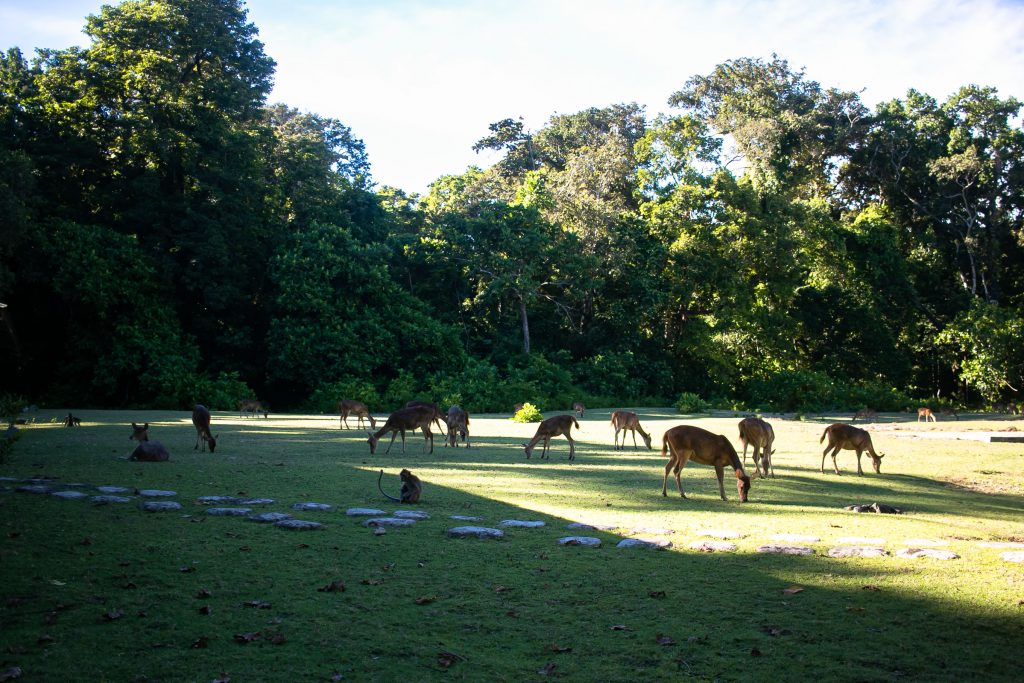
Deer
The deer that graze on the Peucang savanna are mostly doe or female deer and fawn or baby deer. It’s rare to see a stag, or male deer with a horn, here. The stags, especially those that are juvenile and whose antlers are still prone to breaking, tend to avoid open places. They prefer to hide behind the dense forest of Peucang Island. Since if they meet each other, they usually fight. Adolescent stags antlers are still very prone to breaking due to fights. During the mating season, when they have to fight again over a doe, a deer with a broken antler will lose a duel with another stag with a better antler. Any stag in the savanna is a strong, confident male who has won duels with other male deer.
Herds of deer are usually very calm. But they don’t like being approached. Visitors expected to keep their distance. If humans came closer, they would immediately run away. If the herd of deer runs away and hides in the forest, we lose our opportunity to observe them easily.

Wild Boar
Wild boar is an animal which is active at night and during the day. So he is a diurnal and nocturnal animal. Then when do they sleep? Anyway, for people who have never seen a wild boar, encountering a wild boar hanging around without restraint is probably a remarkable and thrilling thing. Wild boar has a large size. Its weight can reach 100 kg. Even though they look fat, wild boars are very agile. Their speed when panicked or feeling threatened is inhumane. Their body color is dark, covered with sharp hairs which they can use as weapons. His nickname is razorback or razor-sharp back. They also have intimidating fangs.
There are many stories of humans being attacked by wild boars. But wild boars in the Peucang savanna have never been seen attacking humans. Likely because they are used to being present or even interacting with visitors. In line with what was conveyed by biologist Oliver (1925), the wild boar with the Latin name Sus scrofa can adapt better to human presence, than other types of wild boar such as the Javan warty pig or the Latin name Sus verrucosus. Even though it doesn’t look aggressive, we should always keep our distance from wild boars. The problem is that wild boar are naturally angry and tend to attack when they feel threatened. Too close a distance for them is considered a threat.
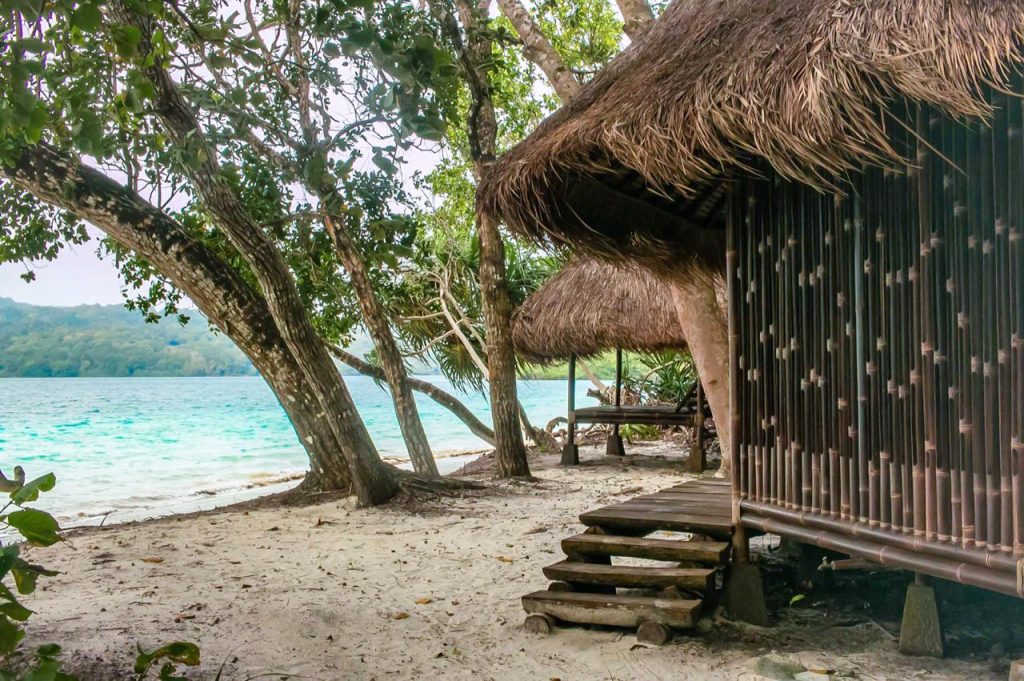
Would you love to get up early?
Deer, monkeys, and wild boars are large mammals that play a crucial role in the forests of Peucang Island. Deer, herbivorous animals that eat leaves, seeds, grass, and fruits that fall in the Peucang Island area, are agents of seed dispersal. The distribution of forage tree species is vital for the life support capacity of the forest. Meanwhile, aside from being a seed-dispersing agent, the monkey controls insect populations. And wild boars are a forest soil fertilizer. He likes to dig in the ground with his snout to find food like worms. They are all guardians of the preservation of Peucang Island.
While on vacation, it seems fun to wake up late and relax all day. It’s okay if you plan like that. But that means we miss the magnificent natural show that only exists in the morning. One of them is seeing the large mammals that guard the preservation of Peucang Island. This article only discusses a small part of the area on Peucang Island, where visitors can easily see animals in the morning. There are still beach areas, shallow seas, and forests which offer natural shows that are no less beautiful. So, let’s go to Peucang Island and get ready to get up early.